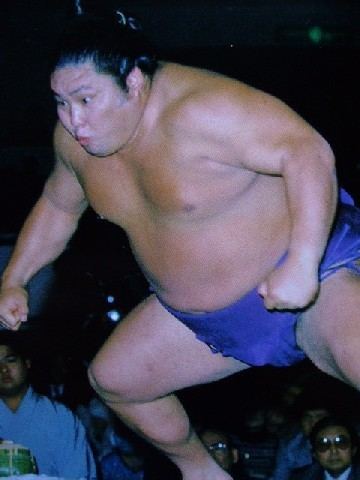Record 493-515-98 Name Itai Keisuke Weight 139 kg Retired September, 1991 Height 1.78 m | Makuuchi rank Komusubi Debut September, 1978 Role Sumo wrestler Career start September 1978 | |
 | ||
Championships 2 (Juryo)1 (Makushita)1 (Sandanme)1 (Jonidan)1 (Jonokuchi) Special Prizes Outstanding Performance (1)Technique (1) Stable Onaruto stable (1978–1991) Similar People Onokuni Yasushi, Daijuyama Tadaaki, Asahifuji Seiya, Takamisugi Takakatsu, Kotogaume Tsuyoshi | ||
Highest rank Komusubi (May, 1989) | ||
Itai Keisuke (板井圭介, Itai Keisuke, born 21 March 1956) is a former sumo wrestler from Usuki, Oita, Japan. His highest rank was komusubi. He held the record for most consecutive victories from entry into sumo for several years before it was broken by Jōkōryū in 2012. After his retirement, Itai caused controversy by claiming that the outcomes of many of his matches were set by match-fixing.
Contents
Career
He won many national youth competitions as an amateur, but worked in the ceramics industry until he was 22. He did not turn professional until September 1978 when he joined the now defunct Onaruto stable. He rose up the rankings in record time, winning his first 26 matches, a record at that time for most consecutive victories from entry into sumo. He reached the second jūryō division just six tournaments after his professional debut. He was given the shikona of Kōtetsuyama, also the fighting name of his stablemaster, former sekiwake Kōtetsuyama Toyoya. He was promoted to the top makuuchi division after winning the jūryō championship in July 1980. However he dropped out of his debut makuuchi tournament on the fifth day without even winning one match. He won promotion to the top division once again after winning another jūryō title in March 1981 but once again dropped out of the following tournament, this time after only three days. Struggling with injuries, he fell all the way down to the unsalaried makushita division. In an effort to change his fortunes, he dropped the shikona and reverted to his real surname, which he was to use for the rest of his career.
Itai finally managed to win a top division bout on his third attempt in November 1982, and came through with his first kachi-koshi or winning score in March 1983. He remained in the top division for 50 consecutive tournaments. Although he was short for a sumo wrestler at just 1.76 m (5 ft 9 1⁄2 in), he was a powerful pusher-thruster, specialising in oshi techniques. He earned three gold stars for defeating yokozuna, all of which were bouts against Onokuni. He lost all 16 bouts against yokozuna Chiyonofuji. His best result in a tournament was 11-4 in March 1989, for which he was awarded two special prizes for outstanding performance and technique. He earned promotion to komusubi for the following tournament, but only managed three wins in his sanyaku debut and never managed to return to the rank. In the July 1991 tournament, ranked at the bottom of the makuuchi division, he lost every one of his fifteen bouts and was demoted to jūryō. He announced his retirement from sumo three days into the following tournament at the age of 35.
Retirement from sumo
Itai was unable to purchase or borrow toshiyori kabu, or elder stock upon his retirement and so was unable to remain in the Japan Sumo Association. As a result, his Onaruto stable folded in 1994 when no successor to his old stablemaster could be found. Itai began a new career as a chankonabe restaurant owner.
In February 2000, in a string of articles published in the tabloid Shukan Gendai magazine, he claimed that during his active career yaocho, or match-fixing was widespread, with up to 80 percent of bouts being prearranged. Wrestlers who had already secured their kachi-koshi would lose deliberately to those still needing wins, in exchange for points to be collected at later tournaments. Wrestlers who had not accumulated points would have to "buy" victories instead for around $2000. Itai claimed the practice was still continuing today, although to a lesser extent. The Sumo Association strenuously denied the allegations, with its chairman Tokitsukaze Oyakata threatening Itai with legal action unless he withdraw his claims. Itai, who had joined a religious group called the God Light Association in the 1980s, said he was on a "mission from God" to reveal the truth behind match-fixing. Others pointed out his restaurant business was struggling and he was well paid for his interviews. Itai claimed to have evidence on tape, but it was never produced publicly and the Sumo Association did not in the end go to the courts.
On 3 October 2008 in the Tokyo District Court, Itai appeared for the defence in a lawsuit brought by the Sumo Association against the Shukan Gendai magazine over further match-fixing allegations. He repeated his belief that 75–80 percent of matches were fixed during his active days, and he stated that only three yokozuna, Onokuni, Takanohana and Wakanohana had not thrown bouts in recent times. He also said he was now working in a glass factory and had no other source of income.
